Difference Between Single and Twin Screw Extruder
Feed extruders are widely used in producing feed pellets for fish and pets. They process high-moisture raw materials under heat and pressure, causing them to expand and cook quickly. This improves how well animals can digest and absorb the nutrients.
Based on their structure, feed extruders fall into two categories: single-screw and twin-screw. Both types can produce expanded pellets, but they differ in several key aspects. The six main differences are explained below.
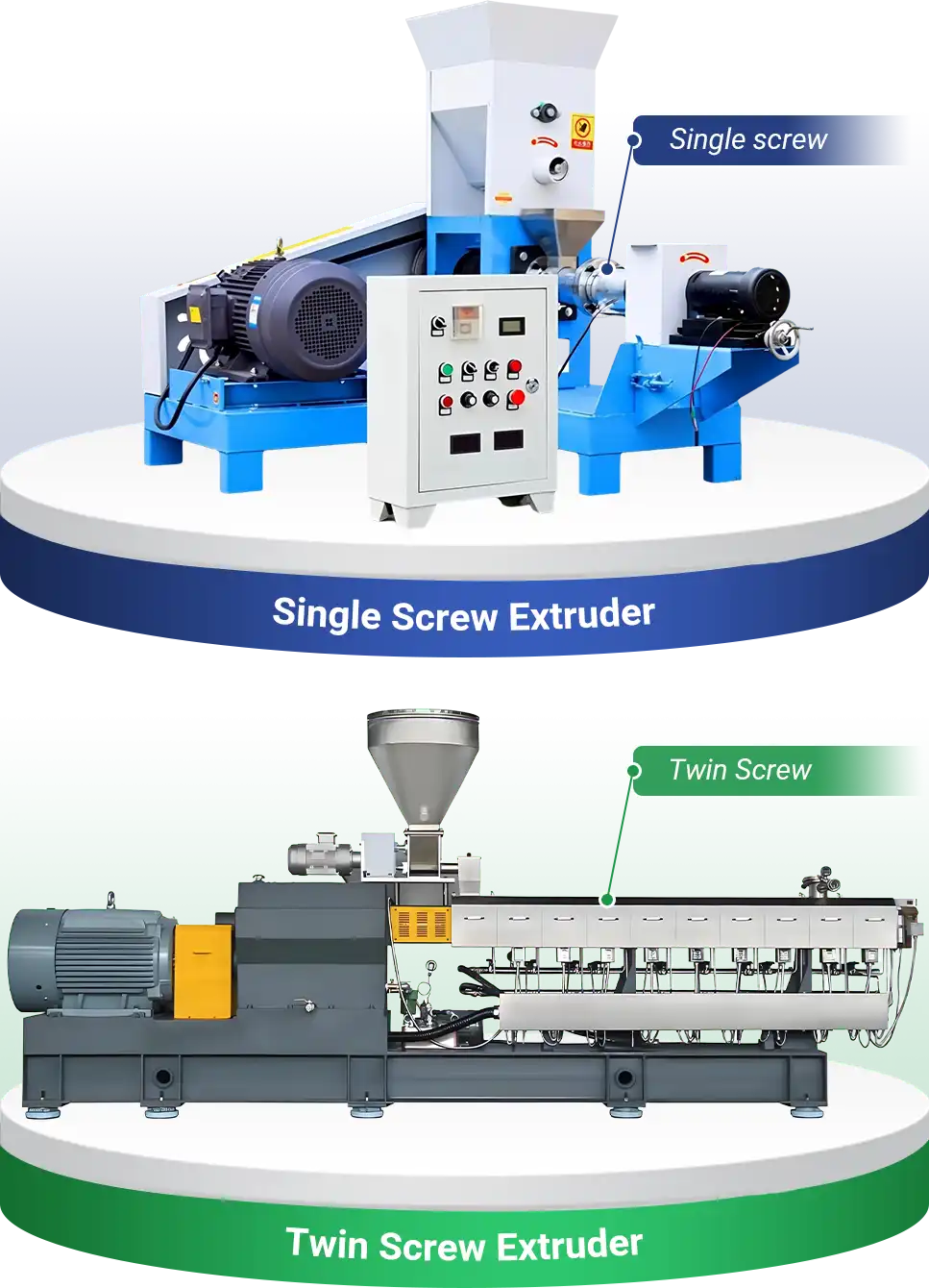
1.Working Principle
The screw is the core component of a feed extruder machine. As it rotates, it mixes, compresses, and expands the raw material under pressure. Screw design directly affects how the material is processed.
How a Single-Screw Extruder Works
A single-screw extruder has one shaft with multiple functional zones: feeding, melting, and forming.
Its operation is similar to a friction-driven piston. After entering the chamber, the material is pushed forward by friction-from itself and from contact with the screw and barrel wall. The screw has a fixed structure, and by gradually changing the pitch and channel depth, it compresses and heats the material before extruding it through the die.

How a Twin-Screw Extruder Works
A twin-screw extruder is equipped with two co-rotating, intermeshing screws made of modular segments. These may include feeding, shearing, compressing, expanding, and other functional sections, which can be flexibly arranged to match specific feed formulas.
The intermeshing screw structure enables forced conveying. Instead of relying on friction, the material is firmly engaged and steadily pushed forward. Between the two screws, it experiences repeated shearing, kneading, and mixing, which ensures uniform and efficient cooking. As it exits the die, the sudden pressure drop causes rapid expansion, forming soft and well-puffed pellets.
(To adjust the expansion level or switch between sinking and floating feed, you only need to reconfigure the screw segments. No full screw replacement is required.)
This structural difference results in different performance in raw material adaptability, pellet quality, production efficiency, and other related aspects.

2.Raw Material Adaptability
Single-screw extruders have relatively limited adaptability to raw materials. They are best suited for simple formulas with moderate oil and moisture levels-typically no more than 12% fat and 25% moisture. As a result, they are often used in standard aquatic and pet feed production.
However, when fat or moisture levels are too high, friction between the screw and the material decreases. This may cause slippage, making it harder to maintain stable flow and temperature. As a result, both output and pellet quality may suffer.
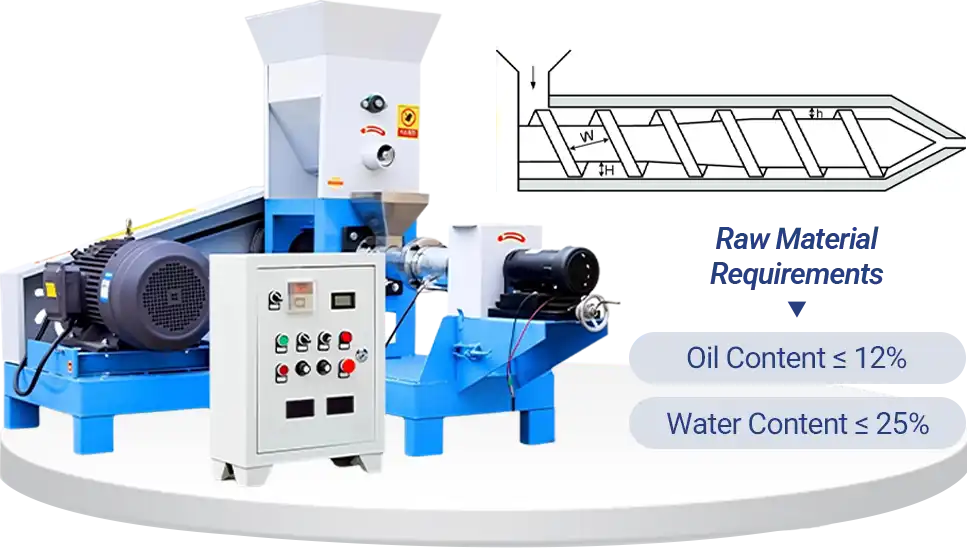
In contrast, twin-screw extruders are more versatile.
The two intermeshing screws move material forward without depending on barrel friction. This allows them to process high-fat (up to 20–25%) and high-moisture (over 30%) ingredients like fresh meat paste.
They are especially effective for pet food and specialized aquatic feed that require complex formulations. They can also produce very small pellets, as small as 0.6 mm in diameter.
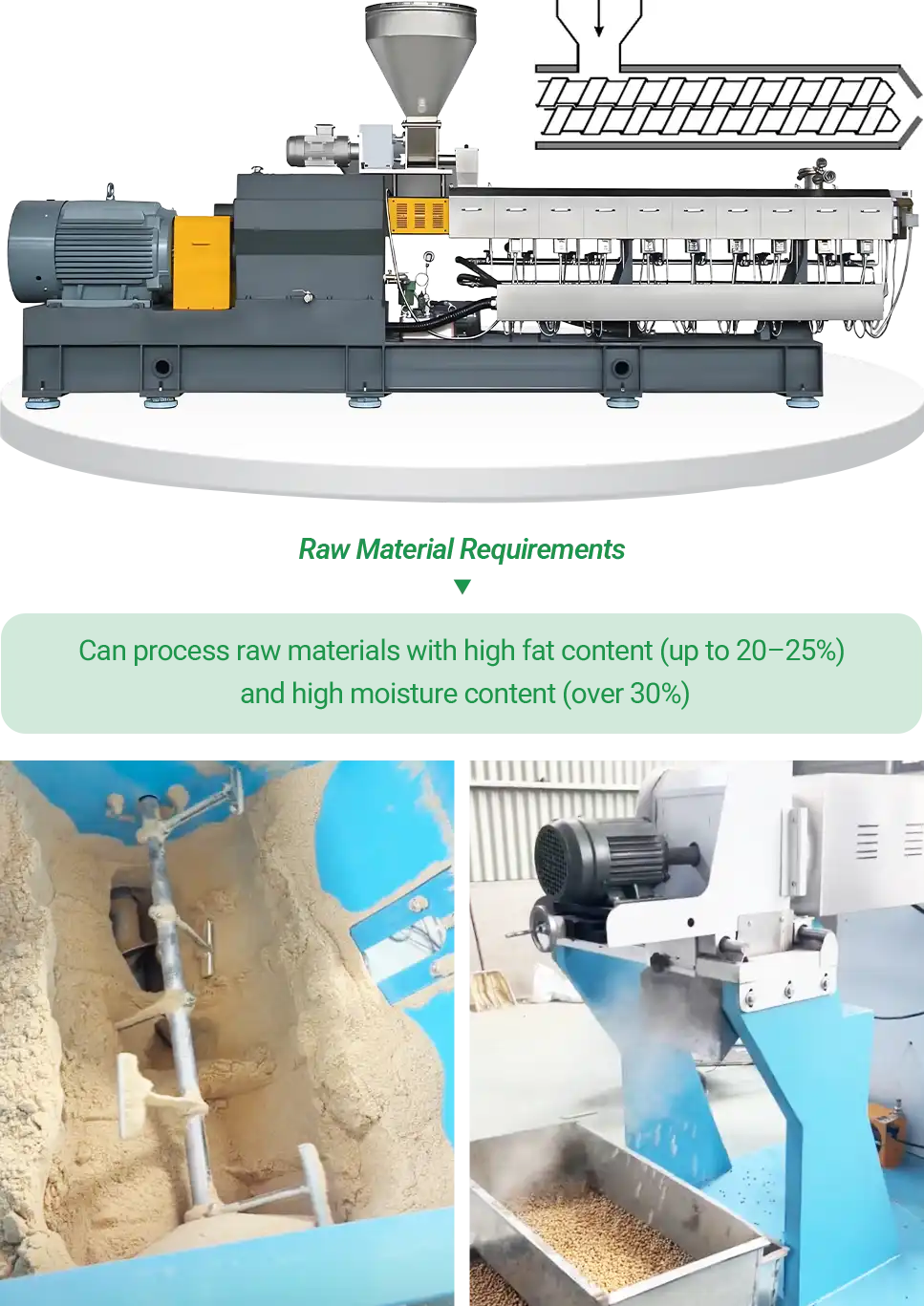
3.Pellet Quality
Single-screw extruders use a single-channel design, which often results in uneven heat and pressure inside the barrel. This can lead to pellets that expand unevenly, with rough surfaces or irregular pore patterns. These issues become more noticeable when the raw material size or moisture level varies. Overall, the pellet quality tends to be less stable.
In twin-screw extruders, the material is mixed and compressed more evenly. The pellets produced are more uniform in shape, smoother in texture, and consistent in size. With better melting and blending, the material cooks more evenly, resulting in dense, uniform pellets that perform better in terms of texture, stability, and nutrition.
Both single and twin-screw extruders can be equipped with conditioners for heat and moisture adjustment. However, structural differences influence how well this process works. The twin-screw system, with strong intermeshing and forced conveying, ensures more even distribution of heat and moisture. This further improves expansion consistency and pellet shaping stability.
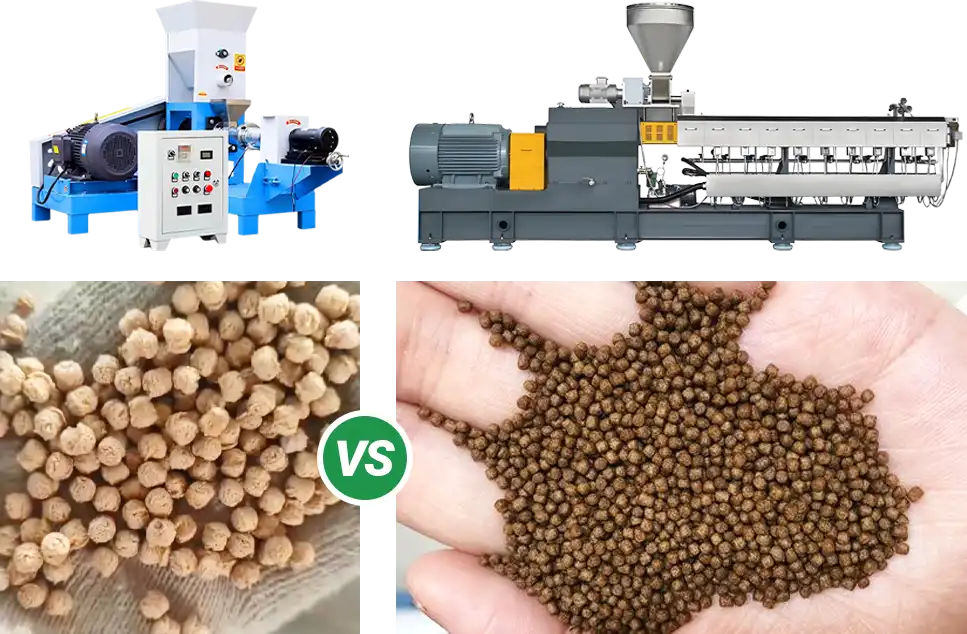
4.Energy Use and Production Efficiency
Twin-screw extruders are more complex and have higher power ratings. However, they consume less energy per unit of output. Their forced conveying and efficient shearing allow the material to heat quickly and evenly.
As a result, processing time is shorter, throughput improves, and energy use per ton decreases. Material conversion rates can exceed 98%, leaving little waste. This means twin-screw machines deliver more output per kilowatt-hour.
That said, they draw more power when running without load or at low capacity. For small-scale or intermittent production, a single-screw extruder may be more practical. For medium to large-scale continuous production, the high output and low waste of twin-screw systems often offset the extra energy use. This leads to better overall efficiency.
5.Ease of Operation and Maintenance
Most modern single- and twin-screw extruders are equipped with variable frequency drives, which simplify basic operation. For more advanced control, twin-screw machines offer additional adjustment options and automation features.
They provide better flexibility and stability for adjusting parameters, monitoring real-time data, and switching formulas during continuous production. As a result, they are ideal for applications that require consistent product quality.
In terms of maintenance, the single-screw design is simpler and easier to disassemble. However, without a self-cleaning function, it usually needs to be cleaned manually after each run. This process can be time-consuming.
Twin-screw extruders have a more complex structure. That said, the intermeshing screws can discharge residual material during operation. By using no-load running or flushing with cleaning materials like cornmeal, most of the cleaning can be completed before shutdown. This reduces both manual cleaning time and downtime, making twin-screw systems better suited for continuous production.
6.Cost Difference
Single-screw extruders feature a simpler design and lower manufacturing costs, making them more budget-friendly.
Twin-screw extruders are more complex and require greater machining precision, which makes them roughly three to four times more expensive than single-screw extruders with similar capacity. As a result, the upfront investment for twin-screw extruders is significantly higher.
The table below summarizes the six main differences discussed above.
| Aspect | Single-Screw | Twin-Screw |
| Structure | Simple; single-channel | Complex; dual-channel coordination |
| Raw Materials | Moderate oil/moisture; basic formulas | High-fat, high-moisture; complex inputs |
| Pellet Quality | Uneven expansion; average consistency | Uniform, smooth, well-cooked pellets |
| Energy & Output | Higher energy per ton; lower conversion | Lower energy use; >98% conversion rate |
| Operation | Simple control; frequent manual cleaning | Self-cleaning; good for continuous runs |
| Cost | Lower price; suits small to medium capacity | Higher cost; ideal for large or premium production |
Both single- and twin-screw extruders have their strengths. Choosing the right machine depends on your production scale, formula complexity, and product goals:
- If you prefer simpler operation and lower upfront cost, and mainly produce small batches or standard formulas, a single-screw extruder is likely the more practical choice.
- For better cooking performance, pellet consistency, and more complex formulas, twin-screw extruders offer greater control and flexibility.
If you're still unsure which option is right for you, our technical team is here to help. We'll provide a professional recommendation based on your specific needs!
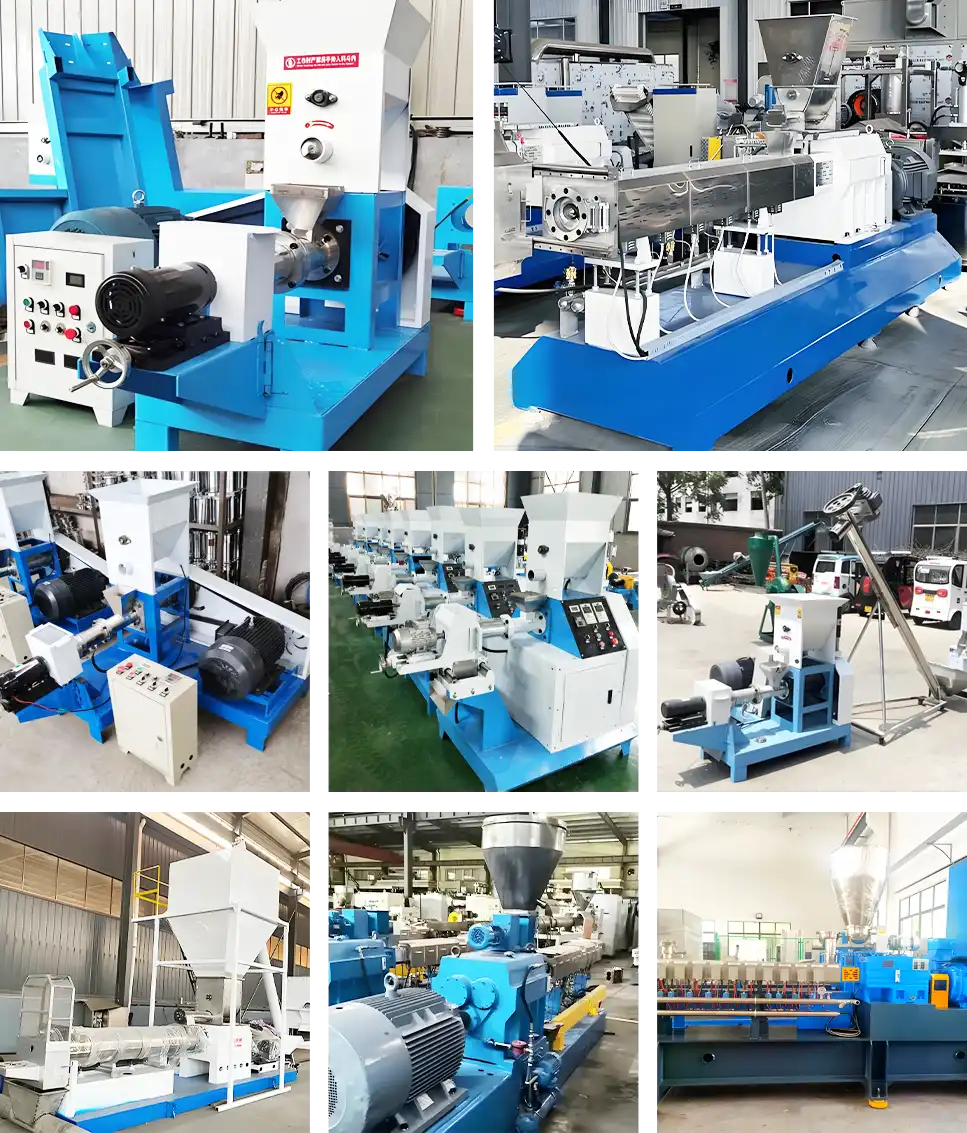

 Online Contact
Online Contact Send Message
Send Message
Need Some Help?
Contact us quickly and we will reply you within 24 hours. We will not disclose your information.